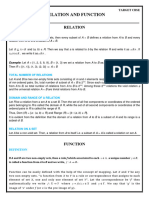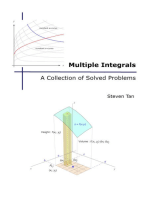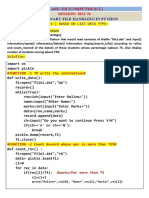Relations and Functions
Uploaded by
khemanikashish46Relations and Functions
Uploaded by
khemanikashish46Relations and Functions
Cartesian product of two sets: Two non-empty sets P and Q are given. The Cartesian
product P × Q is the set of all ordered pairs of elements from P and Q, i.e.,
P × Q = {(p, q) : p ∈ P and q ∈ Q}
Example: If P = {x, y} and Q = {-1, 1, 0}, then P × Q = {(x, -1), (x, 1), (x, 0), (y, -1), (y, 1), (y,
0)}
If either P or Q is a null set, then P × Q will also be a null set, i.e., P × Q = .
In general, if A is any set, then A × .
Property of Cartesian product of two sets:
o If n(A) = p, n(B) = q, then n(A × B) = pq.
o If A and B are non-empty sets and either A or B is an infinite set, then so is the case with A ×
B
o .A × A × A = {(a, b, c) : a, b, c ∈ A}. Here, (a, b, c) is called an ordered triplet.
o A × (B ∩ C) = (A × B) ∩ (A × C)
o A × (B ∪ C) = (A × B) ∪ (A × C)
Two ordered pairs are equal if and only if the corresponding first elements are equal and
the second elements are also equal. In other words, if (a, b) = (x, y), then a = x and b = y.
Example: Show that there does not exist x, y ∈ R if (x – y + 1, 4x – 2y – 6) =
(y – x – 4, 7x – 5y – 2).
Solution:It is given that (x – y + 1, 4x – 2y – 6) = (y – x – 4, 7x – 5y – 2).
⇒ x – y + 1 = y – x – 4 and 4x – 2y – 6 = 7x – 5y – 2
⇒ 2x – 2y + 5 = 0 … (1)
And – 3x + 3y - 4 = 0 … (2)
Now,
Since , equations (1) and (2) have no solutions. This shows that there
does not exist x, y ∈ R if (x – y + 1, 4x – 2y – 6) = (y - x – 4, 7x – 5y – 2).
In general, for any two sets A and B, A × B ≠ B × A.
Relation: A relation R from a set A to a set B is a subset of the Cartesian product A × B,
obtained by describing a relationship between the first element x and the second
element y of the ordered pairs (x, y) in A × B.
The image of an element x under a relation R is y, where (x, y) ∈ R
Domain: The set of all the first elements of the ordered pairs in a relation R from a set A to
a set B is called the domain of the relation R.
Range and Co-domain: The set of all the second elements in a relation R from a set A to a
set B is called the range of the relation R. The whole set B is called the co-domain of the
relation R. Range ⊆Co-domain
Example: In the relation X from W to R, given by X = {(x, y): y = 2x + 1; x ∈ W, y ∈ R}, we
obtain X = {(0, 1), (1, 3), (2, 5), (3, 7) …}. In this relation X, domain is the set of all whole
numbers, i.e., domain = {0, 1, 2, 3 …}; range is the set of all positive odd integers, i.e., range =
{1, 3, 5, 7 …}; and the co-domain is the set of all real numbers. In this relation, 1, 3, 5 and 7
are called the images of 0, 1, 2 and 3 respectively.
The total number of relations that can be defined from a set A to a set B is the number of
possible subsets of A × B.
If n(A) = p and n(B) = q, then n(A × B) = pq and the total number of relations is 2pq.
A relation R from a set A to a set B is said to be a function if for every a in A, there is a
unique b in B such that (a, b) ∈R.
If R is a function from A to B and (a, b) ∈ R, then b is called the image of a under the
relation R and a is called the preimage of b under R.
For a function R from set A to set B, set A is the domain of the function; the images of the
elements in set A or the second elements in the ordered pairs form the range,while the
whole of set B is the codomain of the function.
For example, in relation since each element in A has a
unique image, therefore f is a function.
Each image in B is 2 more than the square of pre-image.
Hence, the formula for f is Or
Domain = {−1, 0, 1, 2, 3}
Co-domain = {2, 3, 6, 11, 13}
Range = {2, 6, 3, 11}
Real-valued Function: A function having either R (real numbers) or one of its subsets as
its range is called a real-valued function. Further, if its domain is also either R or a subset
of R, it is called a real function.
Types of functions:
o Identity function: The function f: R → R defined by y = f(x) = x , for each x ∈ R, is called the
identity function.
Here, R is the domain and range of f.
o Constant function: The function f: R → R defined by y = f(x) = x , for each x ∈ R, where c is a
constant, is a constant function.
Here, the domain of f is R and its range is {c}.
o Polynomial function: A function f: R → R is said to be a polynomial function if for each x ∈
R, y = f(x) = a0 + a1x + ___+ an xna where n is a non-negative integer and a0,a1, ....., an ∈ R .
o Rational function: The functions of the type , where f(x) and g(x) are polynomial
functions of x defined in a domain, where g(x) ≠ 0, are called rational functions.
o Modulus function: The function f: R → R+ defined by f(x) = |x| , for each x ∈ R, is called the
modulus function.
In other words,
o Signum function: The function f: R → R defined by
is called the signum function. Its domain is R and its range is the set {–1, 0, 1}.
o Greatest Integer function: The function f: R → R defined by f(x) = [x], x ∈ R, assuming the
value of the greatest integer less than or equal to x, is called the greatest integer function.
Example: [–2.7] = –3, [2.7] = 2, [2] = 2
o Linear function: The function f defined by f(x) = mx + c , for x ∈ R, where m and c are
constants, is called the linear function. Here, R is the domain and range of f.
Addition and Subtraction of functions: For functions f: X → R and g: X → R, we define
o Addition of Functions
(f + g): X → R by (f + g) (x) = f(x) + g(x), x ∈ X
o Subtraction of Functions
(f - g): X → R by (f - g) (x) = f(x) - g(x), x ∈ X
Example: Let f(x) = 2x – 3 and g(x) = x2 + 3x +2 be two real functions, then
(f + g) (x) = f(x) + g(x)
= (2x – 3) + (x2 + 3x + 2)
= x2 + 5x -1
(f – g) = f(x) – g(x)
= (2x – 3) – (x2 + 3x + 2)
= – x2 – x – 5
Multiplication of real functions: For functions f: X → R and g: X → R, we define
Multiplication of two real functions
(fg): X → R by (fg)(x) = f(x). g(x) x ∈ X
o Multiplication of a function by a scalar
(af): X → R by (a f) (x) = af (x) x ∈ X and a is a real number
Example: Let f(x) = 2x – 3 and g(x) = x2 + 3x +2 be two real functions, then
(fg) (x) = f(x) × g(x)
= (2x – 3) × (x2 + 3x + 2)
= 2x3 + 3x2 – 5x – 6
( 2f )(x) = 2.f(x)
= 2×(2x – 3)
= 4x – 6
Addition and Subtraction of functions: For functions f: X → R and g: X → R, we define
o Addition of Functions
(f + g): X → R by (f + g) (x) = f(x) + g(x), x ∈ X
o Subtraction of Functions
(f - g): X → R by (f - g) (x) = f(x) - g(x), x ∈ X
Example: Let f(x) = 2x – 3 and g(x) = x2 + 3x +2 be two real functions, then
(f + g) (x) = f(x) + g(x)
= (2x – 3) + (x2 + 3x + 2)
= x2 + 5x – 1
(f – g) = f(x) – g(x)
= (2x – 3) – (x2 + 3x + 2)
= – x2 – x – 5
You might also like
- Louis-Pierre Arguin - A First Course in Stochastic Calculus-American Mathematical Society (2021)No ratings yetLouis-Pierre Arguin - A First Course in Stochastic Calculus-American Mathematical Society (2021)289 pages
- Applications of Potential Theory - Fabrikant PDF100% (1)Applications of Potential Theory - Fabrikant PDF456 pages
- Relations and Functions Class 11 Maths NotesNo ratings yetRelations and Functions Class 11 Maths Notes9 pages
- Ncert Exemplar Solution For Class 12 Maths Chapter 1No ratings yetNcert Exemplar Solution For Class 12 Maths Chapter 113 pages
- Relations and Functions Class 11 Notes Maths Chapter 2 - Learn CBSENo ratings yetRelations and Functions Class 11 Notes Maths Chapter 2 - Learn CBSE1 page
- Synopsis - Grade 12 Math Part I: Chapter 1: Relations and FunctionsNo ratings yetSynopsis - Grade 12 Math Part I: Chapter 1: Relations and Functions24 pages
- NCERT Exemplar for Class 12 Maths Chapter 1 - Relations and Functions (Book Solutions)No ratings yetNCERT Exemplar for Class 12 Maths Chapter 1 - Relations and Functions (Book Solutions)44 pages
- Class XII Mathematics Notes Chapter 1 Relations and FunctionsNo ratings yetClass XII Mathematics Notes Chapter 1 Relations and Functions32 pages
- RD Sharma Class 11 Maths Chapter 3 Functions100% (1)RD Sharma Class 11 Maths Chapter 3 Functions27 pages
- Class 11 Maths Relation and Functions NotesNo ratings yetClass 11 Maths Relation and Functions Notes17 pages
- Revision Notes Relation & Functions @ MathletesNo ratings yetRevision Notes Relation & Functions @ Mathletes5 pages
- Maths NCERT Class 12 Math Exampler Problems100% (1)Maths NCERT Class 12 Math Exampler Problems358 pages
- CBSE Class 11 Assignment For Relations and FunctionsNo ratings yetCBSE Class 11 Assignment For Relations and Functions8 pages
- Hyperbolic Functions (Trigonometry) Mathematics E-Book For Public ExamsFrom EverandHyperbolic Functions (Trigonometry) Mathematics E-Book For Public ExamsNo ratings yet
- 2. HW - Worksheet A Topic 2.3 Exponential FunctionsNo ratings yet2. HW - Worksheet A Topic 2.3 Exponential Functions2 pages
- Centum VP Yokogawa Official Training ManualNo ratings yetCentum VP Yokogawa Official Training Manual10 pages
- WWW - Math.iitb - Ac.in/ Swapneel/207: Partial Differential EquationsNo ratings yetWWW - Math.iitb - Ac.in/ Swapneel/207: Partial Differential Equations198 pages
- Topic: Solving Systems of Linear Inequalities Overview:: Property of Diocesan Schools of Urdaneta100% (1)Topic: Solving Systems of Linear Inequalities Overview:: Property of Diocesan Schools of Urdaneta18 pages
- Advanced Technologies, Systems, and Applications V: Papers Selected by the Technical Sciences Division of the Bosnian-Herzegovinian American Academy of Arts and Sciences 2020 Samir Avdaković all chapter instant download100% (3)Advanced Technologies, Systems, and Applications V: Papers Selected by the Technical Sciences Division of the Bosnian-Herzegovinian American Academy of Arts and Sciences 2020 Samir Avdaković all chapter instant download52 pages
- Relations and Functions-Ii: Concept Type QuestionsNo ratings yetRelations and Functions-Ii: Concept Type Questions16 pages
- Regents Exam in Algebra I (Common Core) Sample Items May 2013No ratings yetRegents Exam in Algebra I (Common Core) Sample Items May 201358 pages
- Chapter 8 - Optimization For Engineering Systems - Ralph W. PikeNo ratings yetChapter 8 - Optimization For Engineering Systems - Ralph W. Pike35 pages
- Albrecht and Gaffney.1983.Software Function Source Lines of Code and Development Effort Prediction A Software Science ValidationNo ratings yetAlbrecht and Gaffney.1983.Software Function Source Lines of Code and Development Effort Prediction A Software Science Validation10 pages
- Local Stress Concentrations in Imperfect Filamentary Composite MaterialsNo ratings yetLocal Stress Concentrations in Imperfect Filamentary Composite Materials18 pages
- How To Start Programming in Python - 15 Steps - WikiHowNo ratings yetHow To Start Programming in Python - 15 Steps - WikiHow8 pages
- 02 - Blackburn Et Al. - 2019 - Semtex A Spectral Element-Fourier Solver For TheNo ratings yet02 - Blackburn Et Al. - 2019 - Semtex A Spectral Element-Fourier Solver For The13 pages
- Louis-Pierre Arguin - A First Course in Stochastic Calculus-American Mathematical Society (2021)Louis-Pierre Arguin - A First Course in Stochastic Calculus-American Mathematical Society (2021)
- Ncert Exemplar Solution For Class 12 Maths Chapter 1Ncert Exemplar Solution For Class 12 Maths Chapter 1
- Relations and Functions Class 11 Notes Maths Chapter 2 - Learn CBSERelations and Functions Class 11 Notes Maths Chapter 2 - Learn CBSE
- Synopsis - Grade 12 Math Part I: Chapter 1: Relations and FunctionsSynopsis - Grade 12 Math Part I: Chapter 1: Relations and Functions
- NCERT Exemplar for Class 12 Maths Chapter 1 - Relations and Functions (Book Solutions)NCERT Exemplar for Class 12 Maths Chapter 1 - Relations and Functions (Book Solutions)
- Class XII Mathematics Notes Chapter 1 Relations and FunctionsClass XII Mathematics Notes Chapter 1 Relations and Functions
- CBSE Class 11 Assignment For Relations and FunctionsCBSE Class 11 Assignment For Relations and Functions
- Hyperbolic Functions (Trigonometry) Mathematics E-Book For Public ExamsFrom EverandHyperbolic Functions (Trigonometry) Mathematics E-Book For Public Exams
- Multiple Integrals, A Collection of Solved ProblemsFrom EverandMultiple Integrals, A Collection of Solved Problems
- 2. HW - Worksheet A Topic 2.3 Exponential Functions2. HW - Worksheet A Topic 2.3 Exponential Functions
- WWW - Math.iitb - Ac.in/ Swapneel/207: Partial Differential EquationsWWW - Math.iitb - Ac.in/ Swapneel/207: Partial Differential Equations
- Topic: Solving Systems of Linear Inequalities Overview:: Property of Diocesan Schools of UrdanetaTopic: Solving Systems of Linear Inequalities Overview:: Property of Diocesan Schools of Urdaneta
- Advanced Technologies, Systems, and Applications V: Papers Selected by the Technical Sciences Division of the Bosnian-Herzegovinian American Academy of Arts and Sciences 2020 Samir Avdaković all chapter instant downloadAdvanced Technologies, Systems, and Applications V: Papers Selected by the Technical Sciences Division of the Bosnian-Herzegovinian American Academy of Arts and Sciences 2020 Samir Avdaković all chapter instant download
- Relations and Functions-Ii: Concept Type QuestionsRelations and Functions-Ii: Concept Type Questions
- Regents Exam in Algebra I (Common Core) Sample Items May 2013Regents Exam in Algebra I (Common Core) Sample Items May 2013
- Chapter 8 - Optimization For Engineering Systems - Ralph W. PikeChapter 8 - Optimization For Engineering Systems - Ralph W. Pike
- Albrecht and Gaffney.1983.Software Function Source Lines of Code and Development Effort Prediction A Software Science ValidationAlbrecht and Gaffney.1983.Software Function Source Lines of Code and Development Effort Prediction A Software Science Validation
- Local Stress Concentrations in Imperfect Filamentary Composite MaterialsLocal Stress Concentrations in Imperfect Filamentary Composite Materials
- How To Start Programming in Python - 15 Steps - WikiHowHow To Start Programming in Python - 15 Steps - WikiHow
- 02 - Blackburn Et Al. - 2019 - Semtex A Spectral Element-Fourier Solver For The02 - Blackburn Et Al. - 2019 - Semtex A Spectral Element-Fourier Solver For The

























































































